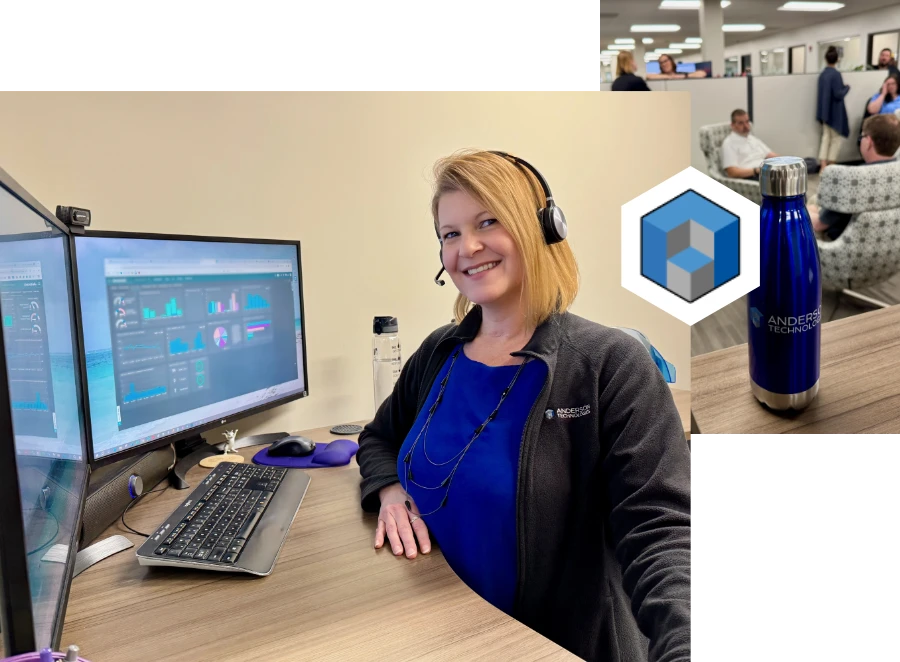What Is Managed IT Services?
– T.C., Operations Manager, Property Management
Managed IT services allows business owners to outsource IT management. Working with a managed services provider (MSP) is an alternative to hiring full-time IT staff or managing your own IT. Managed IT services is also a proactive alternative to engaging “break/fix” services, where the outsourced IT personnel show up only when something is going wrong—often terribly wrong—and when it’s too late to save the hardware or data.
Working with an MSP can save your company a lot of time, money, and unwelcome surprises when it comes to your IT management. MSPs proactively care for your company’s technology and can provide a host of services tailored specifically to your company’s needs.

What Do Managed Services Providers Do?
A trusted MSP wants to keep your business at the top of its game. A good working relationship with your MSP built on trust allows you discuss all your concerns and questions, no matter how complex or simple, and get problems resolved quickly. An MSP should be there for you.
An MSP provides you with an entire outsourced IT department. With a team of experts awaiting your call, MSPs can stay ahead of issues before they become problems. They provide layers of protection for a lower price than hiring IT department.
The expert technicians working for MSPs have a variety of experience to share with different industries, including yours. At their foundation is a multitude of ideas and knowledge to help with any situation that may arise. If a small- to mid-sized business only has the budget for one or two internal IT professionals, that foundation is already limited. What happens when one member of the team goes on a vacation, or moves to another job? Half of the firm’s knowledge base and expertise is gone. An MSP is present for the long term, with no gaps in coverage and 24/7 availability.
Managed Services Essentials
A Trusted Source
Above all, an IT managed services provider must be trustworthy and have your best interests at heart. When looking for the ideal match for your business, carefully research your options. Sign on with an MSP who understands the vision for your company and will help make it the best it can be. Good managed IT services and support brings ongoing technology research, tools, new software and solutions, and awareness of emerging threats and obsolescence issues—like Windows 7 end of support.
Security Audit
One of the first things an MSP should do for their prospective clients is conduct a complete security audit of their business network. This includes inspections and tests of network hardware, backup systems, software, firewalls, and more. While the biggest concerns are addressed, they maintain your security in the background by using remote monitoring and management software (RMM) and professional services automation platforms (PSA) to stay ahead of attacks and implement updates as soon as possible.
There When You Need Them
If you need help fast, MSPs are able to deploy a team at the first sign of trouble. While many IT issues can be resolved remotely, a good MSP is always ready to hit the ground running and assist in any possible way.
Another important benefit of employing an MSP is having a proactive defense against cyberthreats. Ransomware? Hackers? Malware? These are constant threats to businesses, but managed IT services stays ahead of them and is ready to step in immediately in case of a disaster.
Maintaining regular backups is another essential part of managed services. The best way to defend against cybersecurity disasters is to maintain regular backups of your server and files. Inevitably, issues arise, but with reliable backups, whether in the cloud or locally housed, an MSP can get your company back up and running quickly.
Employee Training
People occasionally make mistakes. One day, an employee may be rushing to sort through emails, will see one that looks like something from a trusted client, and will click on the link inside, accidentally downloading malware. This example illustrates why employee training is essential. Training can be provided by a managed IT service.
How about your password policy? As hacking software becomes more sophisticated, passwords must adjust to remain secure. An MSP can train your employees and help implement a solid password policy. Your cybersecurity education should be top priority.
Managed service providers like Anderson Technologies offer cybersecurity training for you and your employees so you can be prepared for the newest threats and know what to do when faced with them.
Affordable
While the initial investment in managed IT may seem daunting, the right partner will save you money in the long run. With new, better technology and managed services, your company will save money through greater uptime, more efficient employees, a more secure network, and avoiding the costs associated with a potential ransomware attack and data breach.
MSPs also have access to software options that individual companies might not be able to consider because of cost or because they don’t reach a minimum number of workstations. However, since MSPs maintain services for many clients, they can purchase software in larger quantities and offer them at a better rate.
Custom planning helps with affordability as well. Many MSPs allow you to pay only for what you need. The same goes for cloud services and backup providers, all of which the MSP can manage for you.
MSPs come in all shapes and sizes just like any other business. Search for one who shares your values and wants your business to become the best it can be. If you’ve outgrown that unresponsive break/fix company, partner with an MSP that can take you to the next level.
A Free IT Assessment Can Help You Identify Risks
Your organization is too valuable to not have modern IT systems to keep it safe and make it scalable. A free Anderson Technologies IT Assessment will identify where you are the most vulnerable and recommend the areas to address first, affording you the most protection and peace of mind.

